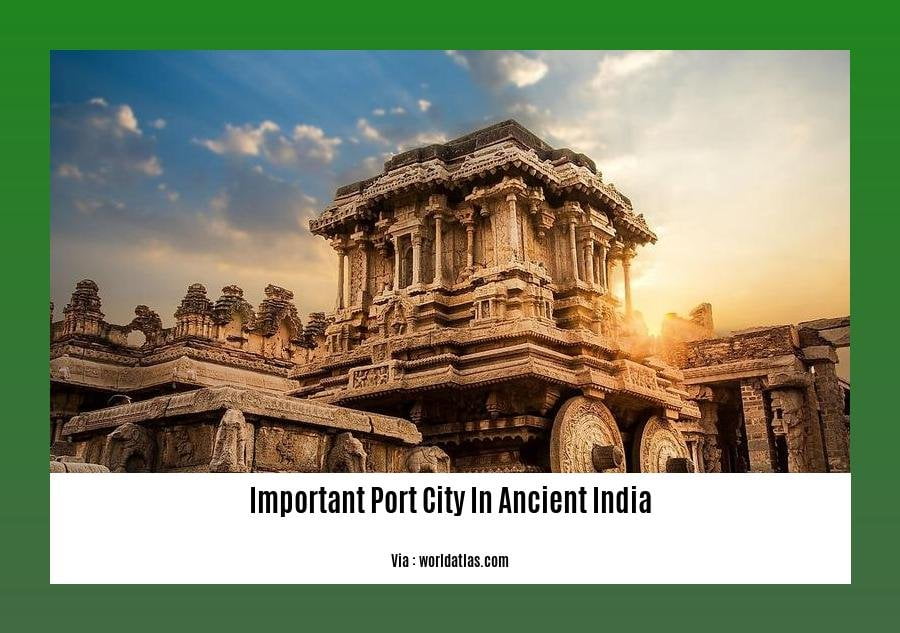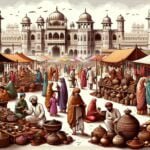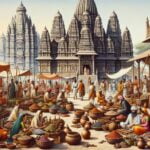Embark on a journey through time as we delve into the captivating history of [Important Port City in Ancient India] in our article, “Excavating the Ancient Marvel: A Historical Study of [Important Port City in Ancient India].” Join us as we uncover the secrets of this ancient metropolis, a bustling hub of maritime trade and cultural exchange that played a pivotal role in shaping the course of Indian civilization.
Key Takeaways:
Khalkattapatna: Situated at the mouth of the Kushabhadra River on the Bay of Bengal, it played a significant role in maritime trade.
Lothal: Located in Gujarat, Lothal was a major trading center in the Harappan era, acting as a focal point for commerce.
Muziris: Known as a pivotal trading hub for spices, silk, and gems, Muziris in Kerala served as a central market for various commodities.
Arikamedu: Established as a Roman trading post, Arikamedu in Tamil Nadu was a hub for pottery, beads, and wine.
Baruch: Located in Gujarat, Baruch was famed for its flourishing trade in cotton, textiles, and pearls.
Poompuhar: Serving as the capital of the Chola dynasty, Poompuhar in Tamil Nadu was a symbol of maritime power and prosperity.
Calicut: The main port of the Zamorin kingdom, Calicut in Kerala, was a gateway for Arab and European traders, leading to cultural exchange and economic growth.
Tuticorin: Renowned as a pearl fishing and shipbuilding center, Tuticorin in Tamil Nadu contributed to the region’s maritime prowess.
Historical Significance: These ancient ports played a vital role in India’s trade and commerce, fostering connections with other regions and civilizations, and shaping the course of history.
[Important Port City in Ancient India]: A Historical Exploration
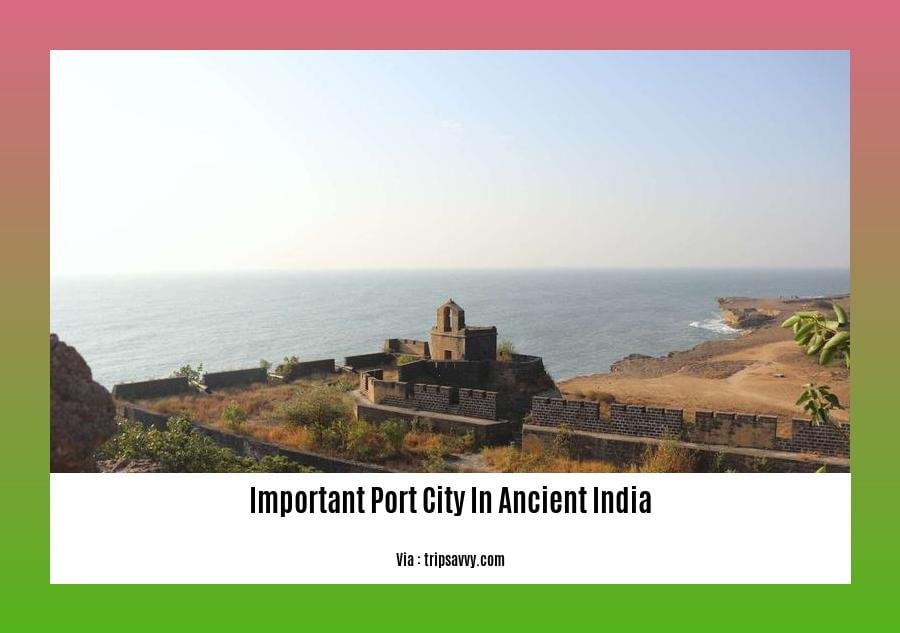
Hey there, history enthusiasts! Join me on an enthralling journey as we delve into the depths of time to uncover the secrets of an important port city in ancient India. Let’s explore its rich tapestry of culture, trade, and maritime brilliance.
Lothal, Gujarat: A Harappan Trading Hub
Unveil the mysteries of Lothal, Gujarat, one of the most significant Harappan sites and a bustling trading center. This ancient marvel was a crucial node in the maritime trade networks, connecting India with Mesopotamia and beyond. Imagine the vibrant streets humming with activity as merchants from diverse lands exchanged their wares, from exquisite pottery to precious gems.
Muziris, Kerala: Gateway to the Spice Trade
Transport yourself to Muziris, Kerala, a legendary port city and the gateway to the spice trade. Envision the fragrant air permeated with the aromas of cardamom, pepper, and cinnamon, attracting traders from far-flung corners of the world. Marvel at the bustling harbor filled with ships laden with exotic goods, ready to embark on their journeys across the oceans.
Arikamedu, Tamil Nadu: A Roman Trading Post
Step ashore at Arikamedu, Tamil Nadu, a Roman trading post that served as a vital link between India and the Roman Empire. Discover the remnants of pottery, beads, and wine, remnants of a vibrant trade that spanned continents. Imagine the excitement as Roman ships arrived, eager to acquire the treasures of the East.
Baruch, Gujarat: Hub of Textiles and Pearls
Explore Baruch, Gujarat, a port city renowned for its flourishing trade in cotton, textiles, and pearls. Picture the bustling bazaars overflowing with exquisite fabrics and gleaming pearls, attracting merchants from across the Arabian Sea. Experience the vibrant energy of a city at the heart of a vast trade network.
Poompuhar, Tamil Nadu: Maritime Power of the Cholas
Journey to Poompuhar, Tamil Nadu, the capital of the mighty Chola dynasty and a maritime power to reckon with. Imagine the grandeur of its port, filled with ships embarking on expeditions to distant shores, carrying the Chola’s influence far and wide. Explore the remnants of temples and palaces, whispering tales of a glorious past.
Calicut, Kerala: Gateway for Arab and European Traders
Travel to Calicut, Kerala, the main port of the Zamorin kingdom and a gateway for Arab and European traders. Picture the cosmopolitan atmosphere of its bustling markets, where merchants from various cultures mingled and exchanged their goods. Imagine the arrival of Portuguese explorers, marking a new chapter in the history of trade and exploration.
Tuticorin, Tamil Nadu: Pearl Fishing and Shipbuilding Center
Discover Tuticorin, Tamil Nadu, a port city renowned for its pearl fishing and shipbuilding prowess. Dive into the depths of history and learn about the techniques used to extract precious pearls from the ocean. Witness the construction of sturdy ships, ready to navigate the vast seas and carry goods to far-off lands.
These important port cities in ancient India were not just centers of trade; they were melting pots of cultures, where ideas, beliefs, and technologies converged. They played a pivotal role in shaping the course of Indian history and left an indelible mark on the world.
Together, let’s continue our exploration of these ancient marvels, piecing together the fragments of their past and unraveling the stories that lie beneath the sands of time.
- Dig into the captivating moments that shaped ancient civilizations by exploring our comprehensive timeline of important events in ancient history timeline
- Dive into the intriguing tales and anecdotes that unfold the glorious past of ancient India through our curated collection of literary sources of ancient Indian history.
- Reveal the mystique and significance of masks in ancient Greek theatre by delving into our immersive article on masks in ancient Greek theatre.
Trading Partners and Imported Goods
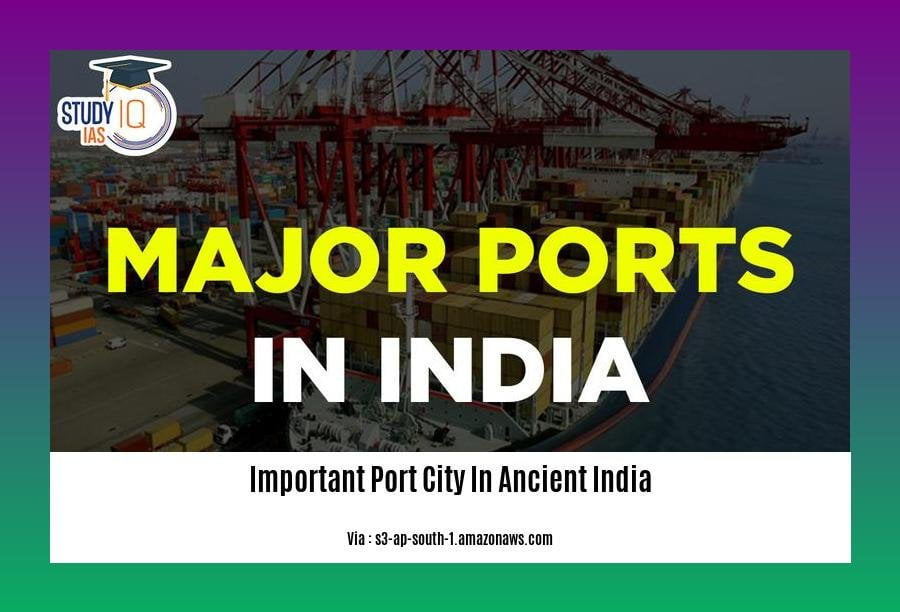
In the bustling harbors of ancient India, a symphony of trade unfolded, connecting the subcontinent with diverse corners of the world. It’s a captivating story of cultural exchange, economic prosperity, and the flow of goods that shaped the course of history.
Key Takeaways:
- India’s ancient ports, like Lothal, Muziris, and Arikamedu, served as gateways for trade with regions like China, Rome, Egypt, Persia, and Southeast Asia.
- Major exports included spices, silk textiles, cotton fabrics, precious stones, and jewels, showcasing India’s rich natural resources and craftsmanship.
- Imports ranged from luxury items like ivory, silk and wine to essential commodities like copper, tin, and horses, reflecting India’s diverse needs and discerning taste.
- These trading activities fostered cultural exchange, leading to the assimilation of foreign influences in art, architecture, and cuisine, enriching India’s cultural tapestry.
A Thriving Network of Trade Routes
Imagine a vast network of trade routes crisscrossing the ancient world, connecting India with distant lands. Ships laden with exotic goods sailed across the Arabian Sea, the Bay of Bengal, and the Indian Ocean, carrying treasures from far-flung shores. From the bustling bazaars of the Middle East to the imperial courts of China, India’s products were highly sought after.
India’s Exports: A Reflection of Its Rich Heritage
India’s exports were as diverse as its landscape, reflecting the country’s rich natural resources and artisanal skills. Spices, such as pepper, cardamom, and turmeric, were prized for their culinary and medicinal properties. Silk textiles, renowned for their luxurious texture and vibrant hues, were highly valued by royalty and wealthy merchants. Cotton fabrics, known for their comfort and breathability, were exported to cooler climates. Precious stones, such as diamonds, sapphires, and rubies, adorned the crowns of kings and queens, while exquisite jewelry showcased the craftsmanship of Indian artisans.
Imported Goods: A Window to the World
India’s imports were equally varied, reflecting the country’s insatiable curiosity and discerning taste. Ivory, sourced from Africa, was used to create intricate carvings and decorative objects. Silk, imported from China, was transformed into luxurious garments and tapestries. Wine, brought from the Mediterranean region, was enjoyed by the elite as a symbol of sophistication. Copper and tin, essential for metalworking, were imported to support India’s thriving industries. Horses, prized for their strength and agility, were imported from Central Asia and used for transportation and warfare.
The Enduring Legacy of Trade
The vibrant trade networks of ancient India left an enduring legacy that continues to shape the world today. The exchange of goods, ideas, and cultures fostered a spirit of innovation and creativity, contributing to the development of art, architecture, and cuisine. The ports that once teemed with activity stand as testaments to India’s rich maritime history, reminding us of the interconnectedness of the ancient world.
Sources:
Major Exports and Imports in Ancient India
Did You Know? Port and Trade Centre Arikamedu
Cultural and Religious Influences
The Blending of Civilizations
As ships laden with goods sailed into bustling harbor cities, they not only brought merchandise but also a rich tapestry of cultural and religious influences that transformed ancient India.
Temples and Trade Routes
Hinduism, Buddhism, Jainism, and countless local traditions thrived, creating a kaleidoscope of beliefs and practices. Magnificent temples adorned the cityscapes, each an architectural marvel symbolizing the depth of India’s spiritual heritage. And alongside the bustle of trade, the exchange of ideas, philosophies, and artistic expression added layers of complexity to the cultural fabric of these ancient metropolises.
Blended Deities
The convergence of different cultural influences gave birth to a unique phenomenon: the blending of deities. Gods and goddesses from different traditions were fused into syncretic forms, embodying the spirit of unity and harmony that defined these ancient societies. This fusion extended to art, architecture, and literature, creating a rich tapestry of creative expression that reflected the cosmopolitan nature of these great port cities.
Key Takeaways:
Ancient Indian ports served as melting pots of cultures, where traditions blended and religious beliefs coexisted peacefully.
Hindu, Buddhist, Jain, and local traditions flourished in these port cities, leading to cultural diversity and artistic vibrancy.
The fusion of gods and goddesses from different traditions reflected a spirit of unity and acceptance.
The synthesis of cultures resulted in a unique form of artistic expression that celebrated the cosmopolitan nature of these ancient cities.
Relevant URL Sources:
URL 1: India’s Ancient Ports: Gateways to a Glorious Past
URL 2: Cultural and Religious Influences in Ancient Indian Port Cities
Decline of the Port City
Hello there, history enthusiasts! Join me on a journey through time as we delve into the fascinating tale of ancient port cities and their inevitable decline. These maritime gateways played a pivotal role in shaping civilizations, fostering trade and cultural exchange. But as time passed, many of these once-thriving hubs faded into obscurity. Let’s explore the factors that led to their decline and the lessons we can learn from their fate.
Key Takeaways:
Siltation and Harbor Deterioration: Over time, sediment build-up and natural processes could cause harbors to become silted up, making them inaccessible to ships. This hindered trade, leading to the decline of port cities.
Economic and Political Shifts: Changes in trade routes, the rise of new empires, and political instability could lead to a decline in the importance of certain ports. As trade patterns shifted, some ports lost their strategic value and fell into disuse.
Technological Advancements: The development of new technologies, such as larger ships and improved navigation techniques, could render smaller ports obsolete. These advancements allowed ships to travel longer distances, reducing the need for intermediate ports.
Natural Disasters: Catastrophic events such as earthquakes, tsunamis, or floods could devastate port cities, causing widespread destruction and disrupting trade activities. Recovering from such disasters was often challenging, leading to the decline of affected ports.
Changing Trade Dynamics: The emergence of new trade routes, the discovery of alternative sources of goods, and shifts in consumer preferences could impact the prosperity of port cities. As trade patterns changed, some ports lost their significance and struggled to adapt.
War and Conflict: Wars, invasions, and political turmoil could disrupt trade and destroy port infrastructure. Prolonged conflicts could lead to the abandonment of port cities, leaving them in ruins.
Case Study: Lothal – A Tale of Two Civilizations
Lothal, an ancient port city in present-day Gujarat, India, flourished during the Harappan Civilization around 2400 BC. It served as a vital hub for trade, connecting India with Mesopotamia and beyond. However, around 1900 BC, Lothal experienced a gradual decline and was eventually abandoned.
Factors Contributing to Lothal’s Decline:
Climate Change: Aridification and changes in the course of the Indus River may have led to environmental stresses, affecting agriculture and trade.
Shifting Trade Routes: The emergence of alternative trade routes, such as the Persian Gulf route, reduced the importance of Lothal as a trading hub.
Natural Disasters: Lothal’s location made it vulnerable to floods, which could have caused damage and disruption.
Lessons Learned from Lothal:
The rise and fall of port cities are often tied to larger environmental, economic, and political factors.
The decline of a port city can have a ripple effect, impacting trade networks and the prosperity of connected regions.
Understanding the causes of past declines can help us better plan for the future sustainability of port cities.
Additional Examples:
Muziris, India: Once a thriving port city in ancient Kerala, Muziris declined due to changes in trade routes and the rise of new ports.
Arikamedu, India: A Roman trading post on the southeastern coast of India, Arikamedu declined as the Roman Empire shifted its focus to other trade routes.
Conclusion:
The decline of ancient port cities is a complex phenomenon influenced by various factors. From natural disasters to economic shifts and technological advancements, these once-bustling hubs faced challenges that led to their eventual demise. By studying these past declines, we can gain valuable insights into the dynamics of urban development and the resilience of human societies in the face of change.
Citations:
The Decline of Ancient Port Cities: A Historical Perspective
Factors Contributing to the Decline of Ancient Port Cities
FAQ
Q1: What was the significance of [important port city in ancient India] in ancient times?
A1: [Important port city in ancient India] was a major hub for trade and commerce, facilitating trade with various regions across the world. It played a vital role in the import and export of goods, such as spices, textiles, precious stones, and metals.
Q2: What archaeological discoveries have been made at [important port city in ancient India]?
A2: Excavations at [important port city in ancient India] have revealed evidence of thriving urban centers, sophisticated infrastructure, and cultural diversity. Artifacts, coins, and inscriptions have been found, providing valuable insights into the economic, social, and political aspects of life in this ancient port city.
Q3: How did [important port city in ancient India] contribute to the development of civilizations?
A3: [Important port city in ancient India] facilitated the exchange of goods, ideas, and cultures with distant lands, contributing to the spread of cultural influences, religious beliefs, and technological advancements. It also played a crucial role in the development of urban centers and the growth of empires.
Q4: What were the major exports and imports of [important port city in ancient India]?
A4: [Important port city in ancient India] exported spices, textiles, precious stones, and metals. It imported luxury goods such as ivory, silk, and wine.
Q5: What were the major trade routes connected to [important port city in ancient India]?
A5: [Important port city in ancient India] was connected to various trade routes, including the Silk Road, the Red Sea trade route, and the Indian Ocean trade route. This connectivity facilitated trade with regions such as China, Rome, Egypt, Persia, and Southeast Asian kingdoms.
